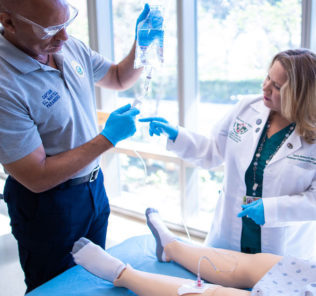How to Build a Clinical Simulation Curriculum
The structure of a clinical simulation program and curriculum are incredibly important elements to a successful clinical simulation program. A well-designed curriculum utilized in the clinical education setting includes the subjects planned to be taught within a clinical simulation program. Common language utilization is a key to success when designing a clinical simulation based education program. This Healthysimulation.com article will focus on curriculum development for a simulation center or program.
When starting out and considering designing a clinical simulation curriculum there is the option to wait for requests from clinical faculty to come in to build scenarios and courses that would benefit their learners. But as many clinical simulation team members will share, the process of creating and testing new scenarios can be incredibly time consuming. Another potential starting point is to consider the resources or curriculum already in use at the institution that could naturally benefit any new design.
If the clinical simulation program is in the infancy stage figuring out how to build out the scenario library is often the most difficult part of building a clinical simulation curriculum. The easiest way to build out a clinical scenario library is to have the faculty design scenarios themselves. Learning how to write scenarios is an acquired skill and some will find it an easier skill than others to do well. Having a template that is standardized across the simulation center is critical to ensuring high quality scenarios are created consistently.
Sponsored Content:
A scenario design template ensures that all information required is more likely to be captured each time. Critical pieces of information to be captured on the template include:
- Which Learning zone will be utilized or what learning objectives are looking to be met.
- Which manikin the scenario calls for.
- What patient monitoring is required.
- Design of moulage if needed
- Simulated patient history and exam findings.
- Expected phases or stages of the scenario to progress through.
These types of templates can easily be built in Microsoft Word or programs such as Canva. Most healthcare simulation programs will also happily share resources such as scenario templates if requested.
Having an overwhelming scenario library with no structure is also difficult to manage when trying to build out a simulation curriculum. A lack of structure in where scenarios are stored can make finding what is needed to run a clinical simulation an arduous position for staff or faculty. The risk of scenarios not being easily located is that this can result in unnecessary work and time of clinical simulation employees that could be using their labor more efficiently. Organization is key to success and this may be found via either having a system for folders on the center’s storage program that utilizes hyperlinks within word documents.
If the healthcare simulation curriculum in question involves multiple areas and many scenarios in the library, organizing by area and sub subject may be the most useful system. For a program with a smaller number of scenarios that relate to specific courses a word document with hyperlinks may be more useful to employees in the clinical simulation program.
Sponsored Content:
Sustainability should also be considered with options such as having popular scenarios in folders pre printed with patient notes already populated and ready to go. These scenarios can be reused or slightly modified easily to fit the needs of the learners involved. Other items to group together for reusing with clinical scenario delivery include an easily reusable patient wrist band and any other relevant moulage pieces for that scenario. These items can be stored in containers or filing cabinets in the simulation room where the scenario most often occurs.
Also of significant importance when building a clinical simulation curriculum is to identify the topics that need to be covered in the scenarios that meet the needs of the learners. Being clear on what learning objectives the simulation program will need to meet for the students and ensuring that those goals are met are required for any program to be successful. Only after information around learning objectives is established can the process of beginning to plan a curriculum begin.
View the HealthySimulation.com CE Webinar How to Make Healthcare Simulation Experiences Clinically Relevant to learn more!
If relevant, incorporating multidisciplinary team training into clinical scenarios design can maximize learning for clinical learners but scenarios that involve a single healthcare discipline can still be incredibly valuable to those involved. Be careful to ensure that the learning objectives are relevant and will be met in the clinical simulation scenario.
If inspiration around clinical simulation scenario possibilities is needed, looking at local emergency policies at the institution belonging to the simulation center is a great starting point for ideas around scenario design. Items such as crash algorithms or institution specific policies and procedures can give critical clues as to what the most common patient emergencies are within specific areas. These institutional policies or procedures should be utilized in the simulated scenarios whenever possible. Another easy way to gain ideas for potential scenarios is to utilize a survey to staff and faculty of
If there is a request for clinical simulation following a reportable event in an area, consider whether enough time has passed prior to running a clinical simulation. The psychological safety of participants in clinical simulation is incredibly important and should always be taken into consideration.Recreating a real clinical event in a medical simulation and having those participants attend may not always be psychologically safe, especially if the training occurs soon after the reportable event took place in real life
Other avenues to look into when planning a clinical simulation curriculum include talking to other programs and courses that may be able to provide assistance. Clinical simulation educators are generally very generous in sharing resources as much as they can.Whether just starting out or trying to clean up decades of disorganized resources, having an effective clinical simulation curriculum is something all healthcare simulation programs should strive towards. The clinical simulation community is full of extraordinary humans and a vast array of creativity. Curriculum development as a field of education is constantly improving and there will always be a need for healthcare simulation programs to be revamping, redesigning and improving their curriculum as healthcare simulation continues to grow and develop.
Reference:
Roussin CJ, Weinstock P. SimZones: An Organizational Innovation for Simulation Programs and Centers. Acad Med. 2017 Aug;92(8):1114-1120. doi: 10.1097/ACM.0000000000001746. PMID: 28562455.
Learn More About Building Clinical Simulation Curriculum
Erin Carn-Bennett is a Simulation Nurse Educator for the Douglas Starship Simulation Programme in Auckland, New Zealand. Carn-Bennett has her Masters of Nursing and has an extensive nursing career within pediatric emergency and also nursing management. She is passionate about debriefing and all things simulation. Carn-Bennett is a member of the IPSS board of directors. Carn-Bennett is the lead host of the podcast Sim Nurse NZ.
Sponsored Content:


















